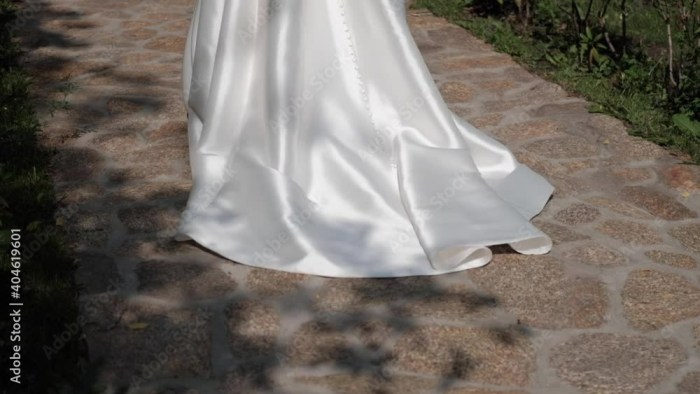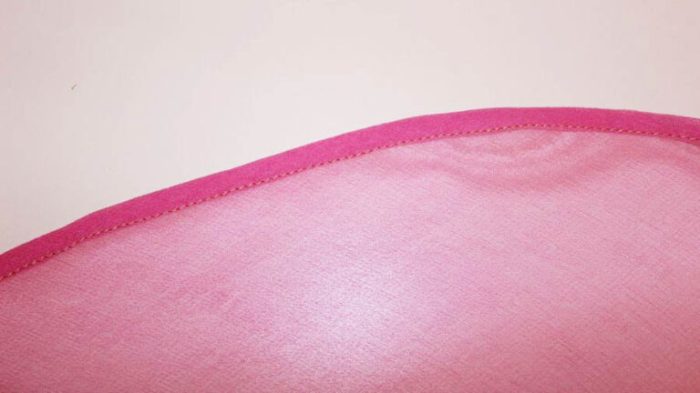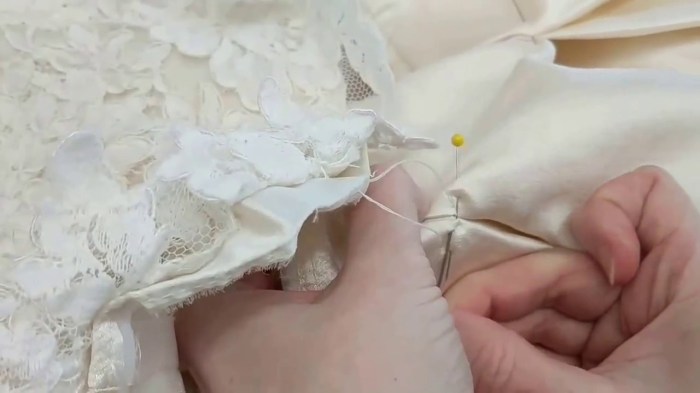Hemming a Wedding Dress A Comprehensive Guide
Hemming Techniques for Wedding Dresses

Source: ftcdn.net
Hemming a wedding dress – Altering the hem of a wedding dress is a crucial step in achieving the perfect fit and silhouette. This process requires precision and attention to detail, ensuring the final look is both elegant and flawlessly executed. Several hemming techniques exist, each suited to different fabrics and dress styles. Choosing the right technique is paramount for a successful outcome.
Types of Hemming for Wedding Dresses, Hemming a wedding dress
Several hemming techniques are suitable for wedding dresses, each offering unique advantages and disadvantages in terms of visibility, durability, and ease of execution. The choice depends on the fabric, dress style, and desired finish.
| Hemming Technique | Visibility | Durability | Ease of Execution | Suitable Fabrics |
|---|---|---|---|---|
| Blind Stitch Hem | Invisible, almost undetectable | High, strong and secure | Moderate, requires practice | Silk, chiffon, crepe, lightweight fabrics |
| Rolled Hem | Minimal, very neat finish | High, durable and strong | Difficult, requires patience and precision | Silk, fine fabrics, sheer fabrics |
| Double-Fold Hem | Slightly visible, clean and professional | High, durable, provides a sturdy edge | Easy, suitable for beginners | Most fabrics, especially heavier materials like satin or brocade |
| Machine Hem | Visible, depending on stitch type | Moderate, reliable if done correctly | Easy and fast | Most fabrics, but may be less suitable for delicate materials |
Visual Guide Descriptions: Each technique’s visual guide would use clear, high-resolution images. For example, the blind stitch would show a close-up (2x magnification) of the stitching on a white silk fabric, highlighting the nearly invisible stitches. The rolled hem image would depict a detailed, cross-section view (10x magnification) showing the fabric’s rolled edge, clearly demonstrating the neatness and precision. The double-fold hem illustration would showcase the folded fabric layers with a crisp, well-pressed edge, emphasized by directional lighting.
The machine hem image would showcase a variety of stitch types, with examples on different fabrics, highlighting the visibility differences.
Tools and Materials Needed for Hemming

Source: ageberry.com
Gathering the right tools and materials is crucial for a successful hemming project. Using high-quality materials ensures a professional finish and durability.
- Sharp sewing shears
- Seam ripper
- Measuring tape
- Tailor’s chalk or fabric marker
- Pins
- Iron and ironing board
- High-quality thread (matching the dress fabric)
- Needles appropriate for the fabric (e.g., microtex needles for fine fabrics)
- Sewing machine (optional, but recommended for speed and efficiency)
- Pressing cloth
High-quality thread and needles are essential. Using thread that is too thick or a needle that is too blunt can damage delicate fabrics and result in an unprofessional finish. A sewing machine can significantly speed up the process, especially for longer hems, but hand-sewing offers more control for intricate detailing.
Preparing the Wedding Dress for Hemming
Proper preparation ensures an accurate and even hem. Pre-washing and pressing are crucial steps before beginning the hemming process.
- Pre-wash the dress according to the fabric care instructions. This prevents shrinkage after the hem is completed.
- Press the dress thoroughly to remove any wrinkles or creases. This ensures accurate measurements and a smooth hemline.
- Measure the desired hem length from the floor, considering the wearer’s shoes. Mark this length consistently around the entire hemline.
- Use tailor’s chalk or a fabric marker to create precise markings. Ensure the markings are even and consistent.
Step-by-Step Hemming Process (Blind Stitch)
The blind stitch offers an almost invisible finish, ideal for delicate fabrics. Follow these steps for a neat and professional result.
- Prepare the hem by turning up the fabric to the desired hem width and pressing it flat. (Image description: Close-up shot of the folded hem, showcasing a crisp, even fold. The fabric is a soft ivory silk, and the fold is precisely 1/2 inch.)
- Using a needle and thread, begin the blind stitch at an inconspicuous point on the inside of the hem. ( Image description: A detailed close-up showing the initial stitch, with the needle entering and exiting the fabric almost invisibly. The thread is a perfect match to the ivory silk.)
- Take small, even stitches, catching only a few threads of the facing fabric. ( Image description: A series of close-up shots, highlighting the tiny stitches taken in the blind stitch technique. The stitches are nearly invisible, and the fabric remains smooth.)
- Continue around the entire hemline, ensuring consistent stitch length and tension. ( Image description: A wide shot of the completed hemline, showcasing the even and invisible stitching. The fabric hangs smoothly and naturally.)
- Tie off the thread securely on the inside of the hem and trim any excess thread. ( Image description: A close-up showing the neatly tied-off thread on the inside of the hem, demonstrating a clean and professional finish.)
Troubleshooting: Uneven hems can be corrected by carefully re-stitching sections, ensuring consistent stitch length. Fabric puckering can be avoided by gently stretching the fabric as you stitch.
Hemming Different Dress Styles

Source: mycrafts.com
| Dress Style | Hemming Considerations | Challenges | Visual Representation |
|---|---|---|---|
| A-Line | Straightforward, consistent hemline | Maintaining even length around the curve | Visual description: A diagram showing a simple A-line dress with a perfectly straight hemline, illustrating the ease of hemming this style. |
| Ball Gown | Requires careful measuring and fitting, often layered fabric | Managing multiple layers of fabric | Visual description: A diagram showing a ball gown with its layered skirt, illustrating how to measure and adjust the hem evenly across multiple layers. |
| Mermaid | More complex, follows the body’s curve closely | Precise adjustments needed to follow the body’s shape | Visual description: A diagram showing a mermaid gown with its close-fitting silhouette, illustrating how to carefully adjust the hem to maintain the dress’s shape. |
Professional Hemming vs. DIY Hemming
Deciding between professional hemming and a DIY approach depends on several factors.
Professional hemming offers expertise and precision, guaranteeing a flawless finish, especially for intricate designs. However, it comes with a higher cost and requires relinquishing the dress for a period. DIY hemming allows for cost savings and personal control but demands skill and patience. The time commitment for DIY is variable depending on experience and dress complexity.
Consider your skill level and the complexity of the dress. For delicate fabrics or complex designs, professional hemming is recommended. For simpler dresses and individuals with sewing experience, DIY is a viable option.
Common Queries: Hemming A Wedding Dress
Can I hem my wedding dress myself if I have limited sewing experience?
For simpler dress styles and fabrics, a beginner might manage with careful guidance and practice. However, complex designs or delicate fabrics may be best left to professionals.
How much does professional hemming typically cost?
Hemming a wedding dress requires precision, ensuring a flawless finish for your special day. Adding delicate embellishments can elevate the look, such as incorporating a beautiful flower wedding dress belt to cinch the waist and add a touch of floral charm. After attaching the belt, the final hemming can be completed, guaranteeing a perfect fit and a stunning overall appearance.
The cost varies greatly depending on the dress’s complexity, fabric, and location. Expect to pay anywhere from $50 to several hundred dollars.
How long does it take to hem a wedding dress professionally?
Professional hemming can take anywhere from a few days to several weeks, depending on the seamstress’s workload and the dress’s complexity.
What happens if I accidentally make a mistake while hemming?
Minor mistakes can often be corrected with careful seam ripping and re-stitching. For major errors, professional help is recommended.



















